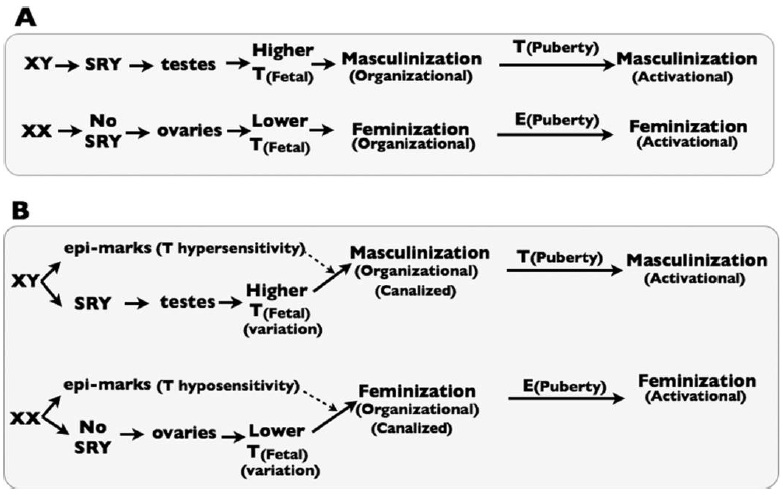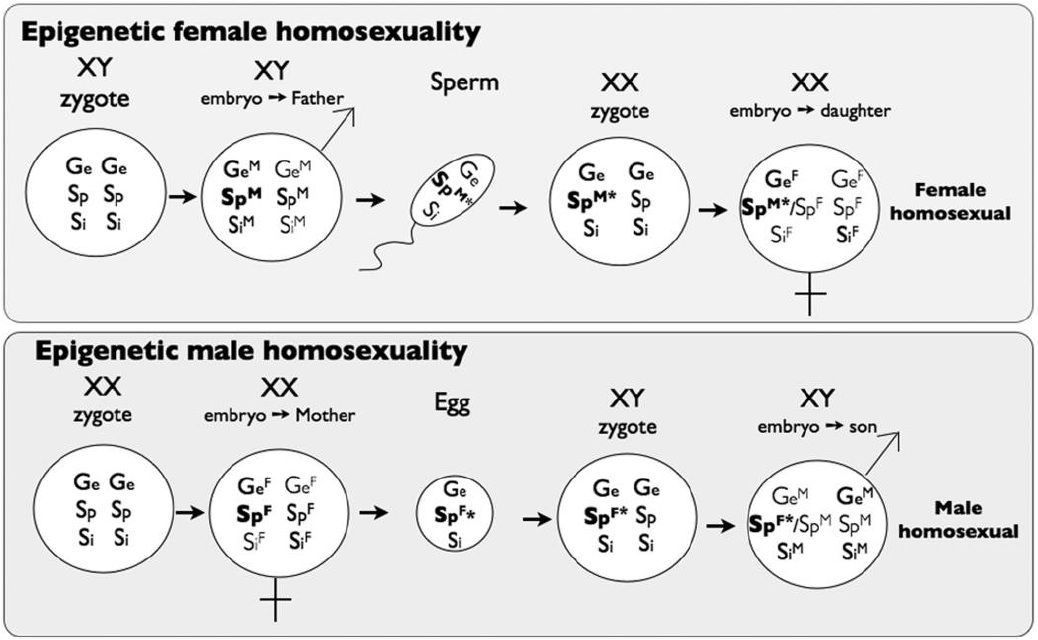
This web page was produced as an assignment for an undergraduate course at Davidson College.
The propagation of scientific information from specialists in the field to laymen in the general populace is an ever-growing priority in this modern technological age. Editors and journalists attempting to inform society on current research outcomes face a continuously expanding job description. In a related report, Kua et al. discuss the challenges associated with this task and provide several guidlines that would improve the transfer of scientific information to all people (Kua et al., 2004). In this analysis, I utilize the various guildlines proposed by Kua et al. to critque a popular press article depicting recent research published on the possible epigenetic causes of homosexuality.
2007 PBS Clip on Epigenetics and Twins
In their paper, "Homosexuality as a Consequence of Epigenetically Canalized Sexual Development", Rice et al. hypothesize that heritable epigenetic markers play a role leading to homosexuality (Rice et al., 2012). They build off of the prenatal androgen paradigm, which attributes sexual development to fetal testosterone concentrations, and add the ammendment that specific epi-marks affect fetal testosterone sensitivity (Figure 1). Usually, these epi-marks are not heritable. However, occasionally they do get passed down to the next generation. The Rice et al. model predicts that testosterone sensitizing epi-marks originate from the father, while testosterone desensitizing epi-marks originate from the mother. With increased testosterone sensitivity, an XX fetus goes through masculinization (the degree depending on multiple epi-marks and other factors). Similarly, with decreased testosterone sensitivity, an XY fetus goes through feminization to some extent. Depending on the degree of feminization of masculinization, homosexuality can theoretically result (Figure 2). The model proposed requires significant laboratory experimentation for adequate verification.

Figure 1. The Sexual Dimorphism Signaling Pathway
The classical view of sexually dimorphic development (A) is that higher androgen levels in XY fetuses and
adults masculinize sexually dimorphic traits and lower androgen levels in XX fetuses and high estrogen in
adults feminizes development. Our analysis (B) indicates that androgen signaling includes an additional
component: it is canalized by epi-marks that are produced during the embryonic stem cell stage of development. (Rice et al., 2012). Permission Pending.

Figure 2. SA-Epi-Marks and Homosexuality
Our SA-epi-mark model predicts that homosexuality is produced by transgenerational epigenetic inheritance.
As in nature, epi-marks are assumed to sometimes carryover across generations (depicted by the “*”
superscript) and epi-mark strengths are assumed to be variable, irrespective of genetic polymorphism (depicted
by the intensity of their letter symbols). Masculinizing (superscript “M”) epimarks are produced in response to
the XY genotype in the early embryo stage (stem cells) and canalize male development by increasing sensitivity
to fetal T. Feminizing (superscript “F”) epi-marks similarly canalize female development by reducing sensitivity
to fetal T. Homosexuality occurs when one or more stronger than average epi-marks—bold, that canalize
sexual preference (Sp), but not the genitals (Ge) nor sexual identity (Si)—carryover across generations into
an opposite-sex descendent and cause gonad-trait discordance when combined with weaker than average
(light) de novo sexually concordant epi-mark(s). (Rice et al., 2012). Permission Pending.
The U.S. News and World Report attempts to convey the findings of this research to the general populace in Jason Keobler's article "Scientists May Have Finally Unlocked Puzzle of Why People Are Gay" (Koebler, 2012). For the most part, the article does a good job at conveying some of the most essential information while putting the results into context. However, there are certain aspects of the report that fail to adhere to the Kua et al.guidelines, which suggest that popular press reporters act as intermediaries, watchdogs, and tool-givers in the public sphere.
For the most part, the article successfully portrays the work of Rice et al. However, the introduction of the article contains various errors that could lead to reader misinterpretation. It initially exaggerates the conclusions of the scientific report by stating that the research "may have solved the puzzle of what makes a person gay..." (Koebler, 2012). While the work of Rice et al. does address the question, it far from states that this epigenetic model is the sole contributing factor to homosexuality. Eventhough Koebler qualifies the statement with "may have", it still could mislead readers. Similarly, the second paragraph provides an untechnical explanation regarding the hereditary transfer of the trait from the mother to son and from the father to daughter. While this seemingly conveys one of the major conclusions of the scientific report, the language used can again be misinterpretted. The epigenetic transfer from parent to offspring is not a transfer of the trait (i.e. it isn't a "gay gene"). Instead, this transfer leads to a sensitization or desensitization to testosterone in the fetus that can result in a continuum of theoretical sexual orientation phenotypes. Ultimately, this ambiguity stems from the lack of a sufficient explanation of epigenetics early on in the article. Koebler covers the bare minimum with a quote from Rice briefly mentioning that the epi-marks involved can occasionally be passed from parent to offspring. While the explanation seems sufficient to functionally differentiate these epi-marks from genes defining them as "an extra layer of information that control how certain genes are expressed. " (Keobler, 2012), it comes too late in the article to avoid reader confusion. Due to the exaggeration of the results in the first two paragraphs, the more realistic reporting in the middle seems nearly contradictory.
Only the beginning of the popular press article struggles with exaggeration. When looking at the article without considering the first two paragraphs, it appears much more consolidated. Explanations are a little overly simplified but still provide an adequate level of understanding (such as with the definition of epi-markers above). The results presented here are well qualified and not exaggerated such as when Koebler states, " a group of scientists suggested Tuesday that homosexuality is linked to epi-marks"(Koebler, 2012). The use of "suggested" and "is linked" depict the uncertain and unverified reality of the study. The results are presented in a historical context addressing the original idea of homosexuality being genetic. The natural selection argument against that (that homosexuality would die out due to a lower likelyhood of reproducing) is concisely mentioned leading to a smooth transition into the epigenetic model. Since epi-marks provide positive selection pressures for the parents (healthy regulation of their testosterone levels), the feasibility of this mechanism appears much more realistic than previous genetic explanations. Additionally, and perhaps most importantly, the article concludes by addressing the incompleteness of the research. After all, the report by Rice et al. was a theoretical mathematical model and needed to be verified through genomic experimentation.
Koebler does a good job playing the intermediary to the general populace. Due to his ability to qualify statements (and generally avoid exageration) and adequately illustrate basic biological concepts including natural selection, epigenetics, and modeling, the major results of the Rice et al. study were simplified but not distorted.
Koebler does not act as a watchdog in this article. According to Kua et al., a watchdog journalist discusses the "social and etihical implications of the work" as well "the interest in the wider picture" (Kua et al., 2004). Throughout the article, the social discussion about homosexuality is barely mentioned. It is only arises in a paragraph regarding the lack of research in this area. Rice states:
"Most mainstream biologists have shied away from studying it because of the social stigma," he says. "It's been swept under the rug, people are still stuck on this idea that it's unnatural. Well there are many examples of homosexuality in nature, it's very common." Homosexual behavior has been observed in black swans, penguins, sheep, and other animals", he says. (Koebler, 2012)
Koebler is an excellent tool-giver. He portrays the timeline of the research done. Not only does he talk about the results, but he also provides the logical progression of the researchers. Furthermore, while he provides the context of past theories, he focuses on the newly proposed model. In fact, he only focuses on past theories enough to illustrate their fatal flaws that the new model overcomes. Most importantly, he avoids exageration at the end of the article, and states the limitations of the model and the future steps that are necessary for it to be more widely accepted. This provides readers with the tools required to actively participate in future discourse on the topic.
Rice, W.; Friberg, U.; Gavrilets, S. 2012. Homosexuality as a Consequence of Epigenetically Canalized Sexual Development. The Quarterly Review of Biology. 87, 343-368. <http://www.jstor.org/stable/10.1086/668167.>
Koebler, J. "Scientists May Have Finally Unlocked Puzzle of Why People Are Gay". U.S. News and World Report. 11 Dec. 2012. Accessed 31 Jan. 2013. <http://www-origin.usnews.com/news/articles/2012/12/11/scientists-may-have-finally-unlocked-puzzle-of-why-people-are-gay>.
© Copyright 2013 Department of Biology, Davidson College, Davidson, NC 28036
Send comments, questions, and suggestions to: johimes@davidson.edu